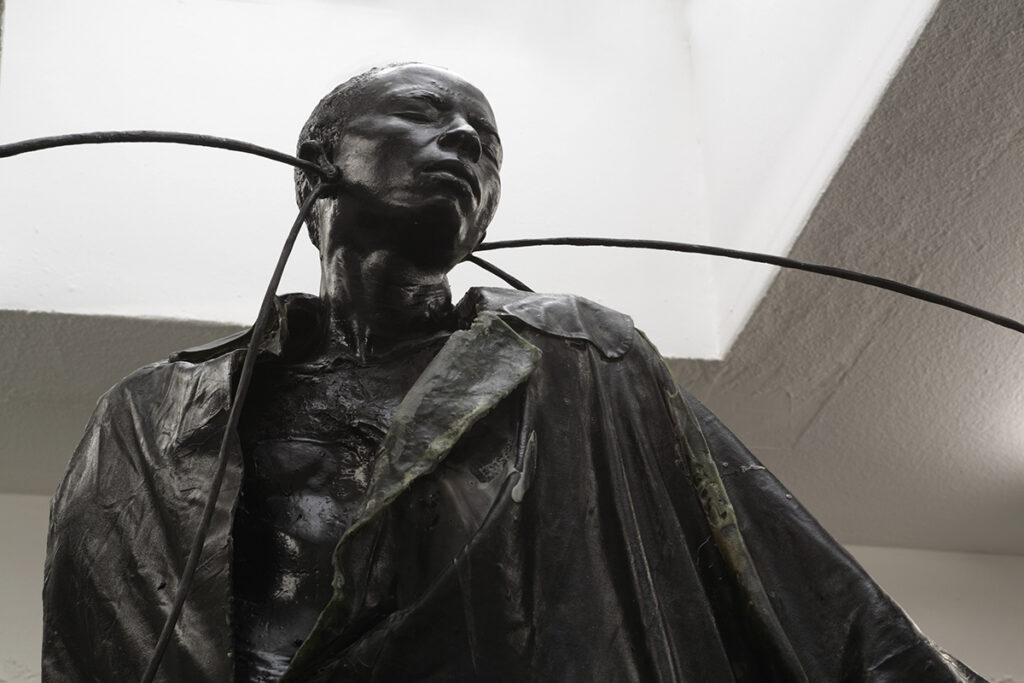Bas de Wit
… the Musical
November 22, 2008 – January 31, 2009

With …the Musical we proudly present on November 22 at 12 am our second gallery exhibition of the Dutch sculptor and painter Bas de Wit (*1977) who was a recipient of this year’s Royal Award for Painting in the Netherlands.
In the center of our exhibition stands the sculpture Toontje Lager, more than 3 m high, made of polyester and PU foam. This sculpture shows three life-size afro-Americans who carry an oversized ghetto blaster on their shoulders as if it was a coffin carried to its grave accompanied by a funeral march. de Wit has produced the sculpture’s elements by casting them in a complex procedure, drawn from life, and he blew them up to a size matching his ideas. The result is that the original ghetto blaster that measures 30 x 40 cm has been enlarged to gargantuan 150 x 250 cm. The scarred faces of the three men carrying the ghetto blaster stem from masks that have been taken in 1910 by European researchers from members of an African tribe. In this tribe scars were considered as adornment and for this reason the masks were exhibited in a Belgian ethnological museum.
Like in earlier pieces, de Wit plays in our current show with clichés, which he is exaggerating, breaking, and connecting to curious new narrative structures. The title Toontje Lager, for instance, leads us to an understanding in this sense of playfully working on chlichés: Toontje Lager means “a little less loud” and it is related to the refrain of the song Shout, performed by Ronald Isley in the American cult movie Animal House (USA, 1978). The gig of a “black” musician at a “white” party at a college mirrors in an emblematic way the status of afro-Americans in the USA in 1962. By relating different elements of an archetypical “white” gaze on “black” culture de Wit is questioning the structures of a history of integration that has come only seemingly to a happy end with the election of Barack Obama to the President of the USA.
With the second large-scale sculpture (310 x 150 x 120 cm) of our show, de Wit is continuing his bizarre game of stereotypes of white eurocentric origin: in the large mouths of two crocodiles that jump out of the water stands a proud black man wearing a green military coat with naked feet. His heavy boots are tied to his earlobes that thereby have deformed to large, protruding ties. The starting point for this work was the motif of the painting Eigenaardig Volk Eerst (peculiar people first) with which in 2004 de Wit drew on the slogan “eigen volk eerst” (“our own people first”) of the right center party. However, in the case of the new sculpture, de Wit goes beyond this critical playing with words. He in fact questions the conditions and limits of sympathies with the fate of strangers who have their own unknown customs. For instance, the man was himself responsible for the pains he experiences by the crocodiles, because he lives out his wish for having gigantic earlobes.
Whereas the production of the sculptures forces de Wit to carry out his ideas in a well-planned procedure, the larger part of his paintings come to life through free improvisation. By turning around the creative procedure that we know from the creation of sculptures – letting the figure come to life by taking away layer after layer of material – de Wit is adding layer upon layer of paint in order to come to images of bodies and facial expressions that lead to narrations. These narrations do not follow a political impetus – different to his sculptures – but allow the viewer an associative view on a bizarre fantastic world.
For instance, the painting SMS, flits, spatie, en locatie (2008, 190 x 190 cm) shows a photographer who advances a group of Pink Panthers. They are about to steal a man’s leopard skin as well as his camera. However, the flashlight of a photographer reminds the Pink Panthers of their history on stage and effects a sort of trance that makes them perform their programme mechanically. Such histories are developed in the course of painting. de Wit is developing them intuitively, by associating new elements to what he has already painted. He is not interested in depicting figures, persons or situations known to us, but wants to enlarge the spectrum and increase the number of possible meanings. Bas de Wit does not tie himself, his works and his viewers down to one specific meaning and he is thereby withdrawing the one, valid narration we might be looking for. Structural openness – regarding form as well as content – can be described as the valid characteristic of his work. He leaves voids in the narrative structure as well as leaving blank parts on his canvases that are either totally free of color or that withdraw themselves as pure abstract painting from what could be considered a particular meaning.